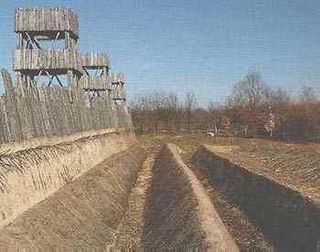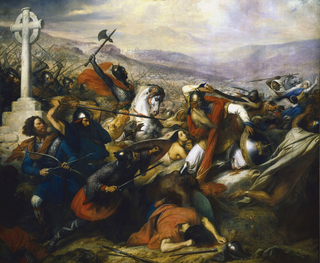Related Research Articles

Louis the Pious, also called the Fair, and the Debonaire, was King of the Franks and co-emperor with his father, Charlemagne, from 813. He was also King of Aquitaine from 781. As the only surviving son of Charlemagne and Hildegard, he became the sole ruler of the Franks after his father's death in 814, a position which he held until his death, save for the period 833–34, during which he was deposed.

Aquitaine, archaic Guyenne or Guienne, is a historical region of southwestern France and a former administrative region of the country. Since 1 January 2016 it has been part of the region of Nouvelle-Aquitaine. It is situated in the southwest corner of Metropolitan France, along the Atlantic Ocean and the Pyrenees mountain range on the border with Spain, and for most of its written history Bordeaux has been a vital port and administrative center. It is composed of the five departments of Dordogne, Lot-et-Garonne, Pyrénées-Atlantiques, Landes and Gironde. Gallia Aquitania was established by the Romans in ancient times and in the Middle Ages, Aquitaine was a kingdom and a duchy, whose boundaries fluctuated considerably.

The Carolingian dynasty was a Frankish noble family named after Charlemagne, grandson of mayor Charles Martel and descendant of the Arnulfing and Pippinid clans of the 7th century AD. The dynasty consolidated its power in the 8th century, eventually making the offices of mayor of the palace and dux et princeps Francorum hereditary, and becoming the de facto rulers of the Franks as the real powers behind the Merovingian throne. In 751 the Merovingian dynasty which had ruled the Germanic Franks was overthrown with the consent of the Papacy and the aristocracy, and Pepin the Short, son of Martel, was crowned King of the Franks. The Carolingian dynasty reached its peak in 800 with the crowning of Charlemagne as the first Emperor of the Romans in the West in over three centuries. His death in 814 began an extended period of fragmentation of the Carolingian Empire and decline that would eventually lead to the evolution of the Kingdom of France and the Holy Roman Empire.

Robert I, was the elected King of West Francia from 922 to 923. Before his election to the throne he was Count of Poitiers, Count of Paris and Marquis of Neustria and Orléans. He succeeded the overthrown Carolingian king Charles the Simple, who in 898 had succeeded Robert's brother, king Odo.

The Duchy of Aquitaine was a historical fiefdom in western, central and southern areas of present-day France to the south of the river Loire, although its extent, as well as its name, fluctuated greatly over the centuries, at times comprising much of what is now southwestern France (Gascony) and central France.

Hunald I, also spelled Hunold, Hunoald, Hunuald or Chunoald, was the Duke of Aquitaine from 735 until 745. Although nominally he was an officer of the Merovingian kings of Francia, in practice Aquitaine was completely autonomous when he inherited it. His rule corresponds to the lowest point of the Merovingian monarchy, when the kingdom was in fact ruled by the mayors of the palace. Hunald was forced at the outset of his reign to accept the authority of the mayor of the palace Charles Martel, but he tried three times to throw it off in open revolt. He was unsuccessful, although he did manage to retain Aquitaine undiminished. In 745, he retired to a monastery, giving power to his son Waiofar. He later went to Rome, where he died during an attack on the city.

Pepin the Short, also called the Younger was King of the Franks from 751 until his death in 768. He was the first Carolingian to become king.
Waiofar, also spelled Waifar, Waifer or Waiffre, was the last independent Duke of Aquitaine from 745 to 768. He peacefully succeeded his father, Hunald I, after the latter entered a monastery. He also inherited the conflict with the rising Carolingian family and its leader, Pepin the Short, who was king of the Franks after 751 and thus Waiofar's nominal suzerain.
Henry was the leading military commander of the last years of the Carolingian Empire. He was commander-in-chief under Kings Louis the Younger and Charles the Fat. His early career was mostly restricted to East Francia, his homeland, but after Charles inherited West Francia in 884 he was increasingly active there. During his time, raids by the Vikings peaked in Francia. The sources describe at least eight separate campaigns waged by Henry against the Vikings, most of them successful.

Investment is the military process of surrounding an enemy fort with armed forces to prevent entry or escape. It serves both to cut communications with the outside world and to prevent supplies and reinforcements from being introduced.

The Umayyad invasion of Gaul occurred in two phases in 719 and 732. Although the Umayyads secured control of Septimania, their incursions beyond this into the Loire and Rhône valleys failed. By 759 they had lost Septimania to the Christian Franks, but would return in the 10th century to establish Fraxinet on the Mediterranean coast in France.

The siege of Narbonne took place between 752 and 759 led by Pepin the Short against the Umayyad stronghold defended by an Andalusian garrison and its Gothic and Gallo-Roman inhabitants. The siege remained as a key battlefield in the context of the Carolingian expedition south to Provence and Septimania starting in 752. The region was up to that point in the hands of Andalusian military commanders and the local nobility of Gothic and Gallo-Roman stock, who had concluded different military and political arrangements to oppose the expanding Frankish rule. Umayyad rule collapsed by 750, and Umayyad territories in Europe were ruled autonomously by Yusuf ibn 'Abd al-Rahman al-Fihri and his supporters.
The siege of Bourbon was a Frankish siege of the Aquitanian fortress of Bourbon in 761 during the Aquitanian War. The Frankish army under King Pepin the Short invested, stormed and burned the fortress, taking the garrison prisoner.
The siege of Clermont was a Frankish siege of the Aquitanian fortress of Clermont in 761 during the Aquitanian War. The Frankish army under King Pepin the Short burned the fortress, with a large number of men, women and children dying in the flames. The Count of Auvergne, Bladinus, was taken prisoner and put in chains, while his Gascon levies were killed or captured by the Franks.
The siege of Chantelle was a Frankish siege of the Aquitanian fortress of Chantelle in 761 during the Aquitanian War. The Frankish army under King Pepin the Short took the fortress in battle. Pepin's army went on to Limoges, laying waste to the province.
The siege of Bourges was a Frankish siege of the Aquitanian fortress town of Bourges in 762 during the Aquitanian War. The Frankish army under King Pepin the Short invested the fort with lines of circumvallation, contravallation and siege engines. The walls were breached and the fort taken. Count Chunibert of Bourges swore his loyalty to Pepin along with his Gascon levies and their families. Pepin appointed several counts of his own to garrison the place and the Frankish army went on to besiege Thouars.
The Battle of Narbonne was a military engagement near Narbonne in 763 during the Aquitanian War. The forces of the Frankish counts Australdus and Galemanius defeated the Aquitanian forces of Count Mantio, killing Mantio and his retinue in the process and routing the Gascon levies in the Aquitanian service.
The siege of Toulouse was a Frankish siege of the Aquitanian fortified town of Toulouse in the winter of 767 during the Aquitanian War. The Frankish army under King Pepin the Short conquered the town and accepted the surrender of nearby Albi and Gevaudan.
The siege of Laon was a Frankish siege of the rebel Grifo's fortified city of Laon in 741. The Frankish army under the Mayors of the Palace, the brothers Carloman and Pepin the Short, besieged the fortress and took Grifo, the Mayors' half-brother, captive.
The siege of Tortosa was a military campaign by King Louis the Pious of Aquitaine in 808–809. It was part of a decade of intense activity by Louis against the Umayyad Emirate in the region of the lower Ebro. The chronology of his campaigns, which must be worked out from both Latin and Arabic sources, is subject to different interpretations.
References
- ↑ Royal Frankish Annals 1970, p. 44.
- 1 2 3 4 Petersen 2013, p. 731.
- ↑ Bachrach 1974, p. 6.